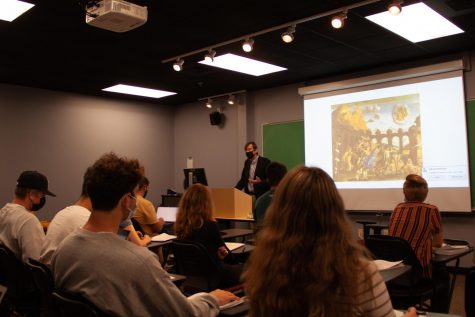Professors and students balance the pros and cons of in-person learning
September 23, 2021
The switch to remote learning offered many challenges for professors and students alike. For many, it was an ordeal that they are glad to see the end of, but for some there were takeaways from online learning that helped them during the return to in-person classes.
Associate Professor of Psychology Pavel Blagov noted that he had to make radical, labor-intensive adaptations to the course to conduct his class in a completely online setting.

When asked about the transition back to in-person learning, Blagov highlighted the fact that many of the adaptations he made for online courses were carried over to the in-person classroom.
“There has been extra effort to return them to in-person format without sacrificing any improvements made during the online year,” Blagov said.
When weighing the pros and cons of each form of learning, Blagov admitted that he was happy to get back to the classroom. Aside from his own personal preferences, Blagov supported the benefits of returning to in-person learning with scientific knowledge.
“In-person teaching more readily engenders basic physiological arousal, which boosts alertness and attention … [which is] known (to psychology nerds) to promote engagement and learning,” said Blagov.
Blagov does not think that this is applicable to everyone, and he knows students who learned better in the online form of learning. In this vein, Professor of History John D. Cotts cited the interaction with his students and the performative aspects of teaching as what he signed up for.
Cotts describes himself as a person who enjoys his job; and to him a great struggle of teaching during the pandemic was that he “got no great pleasure out of teaching from [his] basement.”
This was of especially grave importance as Cotts described the last 18 months as a very stressful time for him personally and for his family. With his wife working as an ICU nurse and his young daughter forced to be at home, Professor Cotts had greater levels of stress to deal with during the pandemic.
Cotts notes that whenever he has been faced with stressful times, he has always been able to turn to what he loves doing most: being in the classroom, interacting with Whitman students and academic writing. With online learning negating many of the aspects he loved most about his job, the pandemic took a great toll on him, and he is more than relieved to find solace once again in his professorial duties.
On the other hand, Professor Blagov did find some enjoyment in online learning.
“Despite the large sizes of my 100- and 200-level classes, I made sure that I met with students in small discussion groups weekly … and checked in with them often,” said Blagov. “I don’t miss the overwork, but I do miss the luxury of having so many weekly conversations with my students.”
When asked about the college’s policy on mask wearing indoors, both professors were in full support of the measure. Although he admits he misses being able to see his students’ expressions, Cotts defers to the epidemiologists and is happy to make the compromise.
From a student’s perspective, remote learning wasn’t all that great. Sophomore Eleshaday Abraha found comfort only in the convenience of being able to attend class from home. Other than that, she found the experience of sitting indoors all day to be depressing and felt disconnected from the school and its community.
On the transition back to in-person learning, Abraha found it quite challenging at the outset. With the added responsibility of extracurricular and social activities, she has found the academic workload harder to bear. Learning to manage her routine has been helpful in adjusting to the return of in-person learning.





